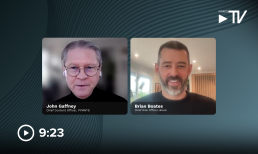There’s no shortage of consulting advice and press clippings that will state the importance of actionable data for companies as a selling, operational and marketing strategy. Big data, it used to be called. But there’s a new data revolution underway and this one is on the consumer side, as financial data aggregators are very much in the news.
 The latest developments come from Mastercard. Last week, the Department of Justice gave the green light to Mastercard’s $825 million acquisition of data aggregator Finicity. Finicity bills itself as an open banking platform, and while that is certainly an attraction as the concept takes hold in the US, for now Finicity is an important portal through which consumers can achieve transparency with their bank as well as plan their current and future financial state. It is an open banking platform on one level and it also is a data management platform for consumers on another. As consumer-permissioned data sharing continues to grow, data aggregators become crucial allies for banks and credit card companies.
The latest developments come from Mastercard. Last week, the Department of Justice gave the green light to Mastercard’s $825 million acquisition of data aggregator Finicity. Finicity bills itself as an open banking platform, and while that is certainly an attraction as the concept takes hold in the US, for now Finicity is an important portal through which consumers can achieve transparency with their bank as well as plan their current and future financial state. It is an open banking platform on one level and it also is a data management platform for consumers on another. As consumer-permissioned data sharing continues to grow, data aggregators become crucial allies for banks and credit card companies.
Craig Vosburg, Mastercard’s president, North America, told Karen Webster in a recent conversation that the deal will better enable people to access and control their data.
“There’s an important role to be played for a trusted intermediary to facilitate that exchange of consumer data in a responsible way that helps encourage innovation,” Vosburg told Webster
The deal will also give rise to strategic collaborations between traditional financial institutions and tech-nimble FinTechs. The end result: Innovation that benefits all stakeholders — banks, digital-first firms (and digital-only ones) and consumers alike.
Vosburg said the movement toward such innovation starts with the data, but doesn’t necessarily end with the payment. Rather, there’s a significant greenfield opportunity to develop new use cases for everyday financial life.
Advertisement: Scroll to Continue
Open banking allows third-party apps and companies to access consumers’ account-level and other financial data (with the express permission of the customers). It is the law in the European Union and is inching toward adoption in the U.S. Vosburg is looking beyond open banking as a concept and said that open banking in general — and the Finicity acquisition specifically — can be viewed as a “new rail in our network of rails. That’s a rail for data and the exchange of data in the right ways, with the right levels of security [and] with the right levels of consumer consent.”
He said the concept of an added rail can bring different stakeholders together to meet consumers’ evolving needs. Those needs will most easily be met by innovative, digital-first firms working with incumbent big banks that want to improve underwriting, broaden wealth management offerings and cement relationships with end consumers, Vosburg said.
Exactly how consumer data gets accessed and maintained has been a source of some controversy, especially around the concept of screen-scraping, which has been a method used by aggregators to access data, but which has more recently pivoted to application programming interfaces (APIs). Vosburg said the correct way to move toward open banking is through APIs, where link-ups with Finicity touch 50 percent of U.S. bank accounts. He said allowing consumer consent to effectively control data access is the right approach to data security.
That’s better than using log-in credentials that are enablers of scraping. Vosburg said those present “obvious targets” for cybercriminals, which can present a burden on bank infrastructure and back offices.
He said the collaborative approach across a wide spectrum of users means that data providers are “willing and complicit, and in agreement on what data is being shared.” Vosburg added that benefits accrue to banks that not only connect with Finicity to provide consumer-level data, but also consume the same data to expand, improve on and even craft new business lines and boost financial inclusion.
He said that with the addition of Finicity, Mastercard will continue to work with a nonprofit organization known as the Financial Data Exchange (FDX). FDX’s stated goal is to unify the financial sector around standardized data-sharing efforts given markets’ growing enthusiasm for open banking.
“It’s important for the industry and for the full breadth of stakeholders to collectively work towards an approach that is responsible and can be executed well,” Vosburg said.
He argued that data sharing is also an area that the U.S. Consumer Finance Protection Bureau (CFPB) will eventually look at as well. “It’s on their docket,” Vosburg said. “I don’t believe they’ve gotten to it yet, but they will.”
For now, Vosburg said some level of education is in order.
In some cases, consumers might not understand what they’ve given a third party permission to do. And the conventional wisdom that banks lose out to FinTechs or that open banking is a zero-sum game is simply not true, Vosburg said. Rather, many banks are becoming more strategic with digital efforts and can leverage their deep relationships and resources to find new revenue streams amid the trend toward open banking.
Looking at the roadmap ahead for open banking, Vosburg noted that the initial use cases might focus on traditional offerings across credit, personal financial management and aggregated account data. That will speed and streamline everything from account openings to onboarding to the creation of digital wallets.
Vosburg added that where financial, asset-level and transactional information can be gathered and presented with ease, firms across any number of verticals can benefit. He pointed to bill payments and identity verification as examples.
“We haven’t even begun to think of all of the potential applications for open banking,” Vosburg said.

 The latest developments come from
The latest developments come from 


